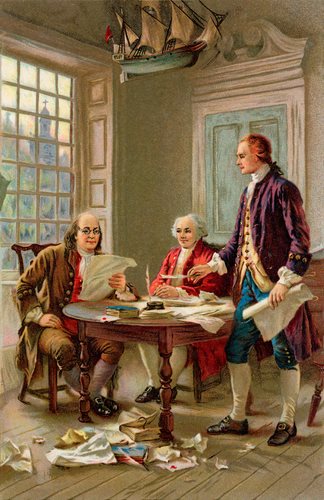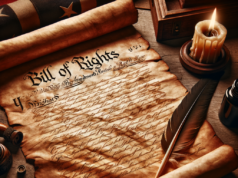
Understanding the Treaty of Paris
The Treaty of Paris, signed in 1783, is a historic agreement that played a pivotal role in shaping the modern world. This treaty marked the official end of the American Revolutionary War and established the terms of peace between Great Britain and the newly formed United States of America. To understand the significance of the Treaty of Paris, it is essential to explore its context, key provisions, and long-lasting impact.
Historical Context
The Treaty of Paris came at the culmination of the American Revolutionary War, a conflict that began in 1775 when American colonists rebelled against British rule. After eight years of fighting, both sides had reached a point of exhaustion and realized the need for a negotiated settlement.
Key Provisions of the Treaty
1. Recognition of Independence: The most critical provision of the Treaty of Paris was the recognition of the United States as an independent and sovereign nation. Britain acknowledged the former Thirteen Colonies as free and independent states.
2. Boundaries of the United States: The treaty defined the boundaries of the United States, establishing the Mississippi River as the western boundary, the Great Lakes as the northern boundary, and Florida as the southern boundary.
3. Fishing Rights: The treaty granted American fishermen the right to fish in the waters off the coast of Newfoundland and the Gulf of Saint Lawrence, preserving access to valuable fishing grounds.
4. Debts and Loyalists: The treaty ensured that American creditors would be paid for debts owed to British merchants before the war. It also stipulated that Congress would recommend to the states that confiscated Loyalist property be returned or compensation provided.
5. Prisoner Exchange: Both sides agreed to release prisoners of war and allow for their repatriation.
Impact of the Treaty of Paris
The Treaty of Paris had far-reaching consequences that extended beyond the end of the Revolutionary War:
1. International Recognition: The treaty’s recognition of American independence paved the way for other nations to establish diplomatic relations with the United States. It was a significant step in the nation’s path to international recognition.
2. Territorial Expansion: The establishment of clear boundaries in the treaty allowed for the westward expansion of the United States. The acquisition of land beyond the Mississippi River laid the foundation for the nation’s growth.
3. Economic Implications: The fishing rights granted to the United States were economically valuable, as fishing was a crucial industry in the early republic.
4. Loyalist Resettlement: The treaty addressed the fate of Loyalists who had supported the British during the war, providing some restitution for their confiscated property and allowing for reconciliation.
5. Peace and Stability: The Treaty of Paris brought an end to the hostilities between the United States and Great Britain, contributing to a period of relative peace and stability in North America.
Legacy and Significance
The Treaty of Paris is a testament to the power of diplomacy in resolving conflicts and shaping the course of history. It not only secured American independence but also established a framework for international relations that influenced subsequent treaties and agreements. The treaty’s provisions helped define the geographic boundaries of the United States, laying the groundwork for the nation’s territorial expansion. In essence, the Treaty of Paris marked the beginning of the United States’ journey as a sovereign nation and its emergence on the world stage as a diplomatic player.
The Treaty of Paris was a doctrine signed by both British and American representatives on September 3rd, 1783, which officially, diplomatically, and politically solidified the independence of the United States of America from the British monarchy. Though the Revolutionary War had ended in 1776 – unofficially establishing the United States of America as a sovereign nation – the Treaty of Paris formulated diplomatic parameters by which both the British and American nations were required to abide.
Once the British monarchy, now under the rule of King George III, recognized the United States of America as an independent, sovereign nation, other European powers such as the French, Spanish, and Dutch were inclined to follow suit. As a result, a framework of guidelines was established in the Treaty of Paris in order to ensure respectful diplomacy between the newly-borne United States of America and its European counterparts.
Authorship of the Treaty of Paris is credited to Benjamin Franklin, John Adams, and John Jay. The fundamentals expressed within the text of the Treaty of Paris address various contingencies and situations, ranging from diplomacy, commerce, and the specification of borders. In addition, so as to not repeat the perceived tyranny of the British monarchy under King George II, the authors included clauses within the Treaty of Paris that ensured fair and just dealings with the British Loyalists – both freed, as well as those in captivity – who still remained in the United States of America. The Treaty of Paris is considered to be the United States of America’s first dogmatic doctrine establishing foreign policy.
Many American political figureheads, as well as early settlers, were adamant about the westward expansion. However, the authors of the Treaty of Paris were wary of conducting tyrannical diplomatic dealings and, as a result, they were meticulous in their establishment of borders prior to allowing settlers to colonize the Western frontier. Settlers who wished to participate in the westward expansion were permitted to colonize what we now know as Ohio, Indiana, Illinois, Michigan, Wisconsin, and some of Minnesota. By regulating westward expansion, diplomatic relations could be maintained as a result of preventing the encroachment onto territory that belonged to other European nations.
The Treaty of Paris demanded that specified unclaimed lands be shared by multiple nations. For instance, both British and American merchants were permitted to cultivate the land and sea on eastern-coastal Canadian provinces, such as Nova Scotia.
The Revolutionary War granted the United States of America independence from British rule, and after their defeat, a majority of British citizens returned to England. However, the Loyalists who remained willingly, and even those who were in captivity, found themselves to be a minority amongst the newly-established United States citizens; a dynamic that created opportunities for the exploitation of the remaining British loyalists.
British loyalists, both free, as well as in captivity, were robbed of their lands and possessions, many times without reason or sound justification. The authors of the Treaty of Paris delineated their democratic principles from the pre-existing behaviors of the British Monarchy and, as a result, all land unlawfully seized from British Loyalists was ordered to be returned. In addition, all prisoners (both British and American) were ordered to be set free and allowed a safe return to their respective homelands.
Finally, the Treaty of Paris instructed that all lawful debt be collected in a fair and just manner, regardless of the nationality of the debt holder. Both British and American citizens were treated equally.
The Treaty of Paris represents the United States of America’s first diplomatic endeavor. As a result of their unjust treatment by the British monarchy, the authors of the Treaty of Paris wished to portray a more humane and just method of diplomatic dealings.

























